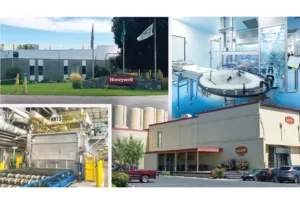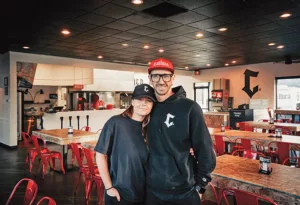
Home » Millwood sets stage to attract business
Millwood sets stage to attract business
City plans projects intended to improve safety, walkability

March 15, 2018
The little city of Millwood is in the midst of a transformation, some say, with several projects in the works that are aimed at improving infrastructure and attracting new businesses.
Surrounded by the city of Spokane Valley on three sides, Millwood covers an area slightly less than three-quarters of a square mile, with its west border at Vista Road and its east border at north Butler Road. The Spokane River serves as the city’s northern limit, while Trent Avenue marks its southern edge.
Millwood Mayor Kevin Freeman says the town became the first incorporated city in Spokane Valley in 1928 and now has a population of just under 2,000 residents.
“We started as a small community that built up around the needs of employees of the mill, which is known today as Inland Empire Paper Co.,” he says. “For many years, we stayed small, with no great desire to expand or add services.”
During the last two years, however, Freeman says the city has completed several projects in an effort to continue improving the city’s infrastructure and safety—and to help attract new businesses to its commercial areas. The completed projects include installing new LED lighting in streetlights throughout the city, updates to sidewalks between Buckeye and Grace avenues, and the installation of a signal at the Union Pacific Corp. railroad crossing at Marguerite Road.
Freeman says those improvements appear to have encouraged new businesses, such as Wildflowers Vintage and Millwood Brewing Co., to take on renovations in older buildings near Argonne Road.
Wildflowers Vintage opened last August in the former Company Ballet School studio at 3201 N. Argonne, and Millwood Brewing renovated the former Cunningham photo studio building at 9013 E. Frederick.
Jeff Postlewait and his wife Julia, are the owners of Rocket Bakery, a business they started in Millwood in 1992. The bakery now boasts a total of seven locations throughout the greater Spokane area, but the original shop remains open at 3315 N. Argonne.
“Millwood was a great start for us, and we really love being here in this community,” says Postlewait. “Anytime we can encourage people to come here and start a business, we do so.”
Postlewait says some construction projects have been hard on businesses over the years, but most have ultimately proven beneficial for the neighborhood.
“Anything that reduces heavy traffic and makes it easier to access businesses is usually a good thing,” he says. “We could use more in the way of beautification-type projects, which might do more to attract new businesses, but it’s difficult to add those things with so much traffic in the area.”
Freeman says the city plans several more infrastructure improvement projects this year, including repairs to sidewalks and a parking expansion at Millwood Park, located along Frederick Avenue just east of Millwood City Hall. The city also plans continued road work between Buckeye and Grace avenues, as well as two larger projects—the creation of the Millwood Interurban Trail, and the Argonne congestion relief project.
The Millwood Interurban Trail is a $1.5 million project that will create a one-mile pedestrian and bicycle path along a former Great Northern Railroad right of way, which crosses through Millwood south of the active Union Pacific rail line from Vista Road all the way to the Trent Avenue overpass.
Freeman says construction on the project is scheduled to begin later this spring and continue through fall.
“We’ve also been working with the West Valley School District to ensure the trail is a safe route of travel for students, between the school and Millwood City Park,” he says.
Freeman says the city’s other large venture, the $1.2 million Argonne congestion relief project, is currently in the early design phase.
“This project will add turning lanes to Argonne at Euclid, Dalton, and Liberty avenues,” he says. “We’re hoping to widen the road and allow for safer east-west crossings in those areas.”
Because Argonne Road is a main thoroughfare for the city—and a main north-south arterial between Spokane Valley and Green Bluff—the road is often a source of many of its challenges.
“It’s like a moving wall,” he says. “Between vehicles and the railroad, we get lots of heavy industrial traffic coming through, so it can be difficult to keep everyone safe and happy.”
Freeman says one of the most impactful projects undertaken by his predecessor, Dan Mork, was the $1.3 million Argonne Road reconstruction completed in 2009, which rehabilitated the road and replaced sidewalks along it.
Millwood resident Shirene Young is the business manager for Inland Empire Paper Co. and also serves as head of the Millwood Community Association, an organization that she says was formed in response to the Argonne Road project.
“The city was concerned about the project’s impact and felt it might be beneficial to form a group to act as a voice for residents and businesses,” says Young.
“We helped keep the community aware of construction plans and potential impacts, and once it was complete, we organized a ‘take back our streets’ event to encourage people to revisit area businesses.”
She says that initial event evolved into what is now the city’s annual Millwood Daze festival in August.
“The MCA has about 25 active members, and others who participate in events to varying degrees throughout the year,” says Young. “We invite all residents, businesses, and property owners associated with the greater Millwood area to participate.”
Like Freeman, Young describes Millwood as a community that initially was created to serve the needs of workers at the paper mill.
“Many of our city’s mayors have had good continuing connections with the mill and worked in conjunction with our company to improve the community,” she says.
Young says she started working for Inland Empire Paper in 1990 and moved to the Millwood area herself in 1994.
She says her position with Inland Empire Paper and her involvement with the MCA have enabled her to interact with many of the community’s residents and business owners, and share in their excitement over developments taking place there.
“We’re a small, historic district that’s situated near several railroad crossings and a major industrial thoroughfare,” she says. “Most of our residents want to maintain that charm, while also creating more parking and safe, walkable crossings.”
Young says most of the city’s commercial properties can be found along its busiest roadways; Argonne, Euclid, and Trent.
“It’s particularly difficult to attract new businesses to Euclid because of how close it is to the railroad,” she says. “That makes it a challenge to create parking and pedestrian crossings that don’t disrupt traffic.”
Young says the city’s recent effort to add a lighted crossing at Marguerite Road has helped to ease some of those safety concerns, and upcoming plans to add a fence and additional parking along Euclid seem encouraging.
She says residents also have been encouraged by the city’s recent efforts to repair roads and sidewalks, and re-paint the water tower.
“These projects have really enhanced safety and given the area a fresh, inviting look,” she says. “Upcoming plans for new gateway signs should also help guide visitors to the neighborhood and create a sense of identity for our residents.”
Young says residents also have been excited to see businesses like Millwood Brewery developing in the area, and eagerly await the start of new projects, particularly plans to improve the city park and develop the Millwood Interurban Trail.
“The city park is a very popular destination in the summer, so more parking there will be a huge improvement,” she says.
She adds, “Many people are also excited by the idea of a good walking trail with interpretive signs. A lot of them also see the trail as an opportunity for a safer, off-street connection for school kids and pedestrian traffic.”
Young says she believes the changes occurring in Millwood now will put it on a path toward becoming a more attractive, walkable city.
“I think that vision is possible if we keep communication open and continue to embrace all the unique things that make us such a great community,” she says.
Looking ahead, Freeman says it’s important for the city to remain proactive its improvement plans and to continue to work with its municipal partners on plans for Argonne Road, and community trail connections.
“We have to be somewhat aggressive in pursuing funding and generating interest because without that drive, good projects never get started,” he says.
Freeman, a resident of the city since 1998, was elected mayor in 2014 having previously served eight years on the Millwood City Council. He says he’s serving his second and final term as mayor.
Freeman says his predecessor Mork, who served as mayor from 2006 to 2013, played a big role in bringing about many of the improvements the city has seen in the last 10 years.
“Dan did a lot to move the city toward public works improvements, and enhance commercial and residential opportunities here,” says Freeman. “As we go forward, we hope to continue that work.”
As mayor, Freeman says his focus has been on enhancing public works and addressing concerns facing businesses, while striving to respect the needs of Millwood residents.
“Once I was elected, one of the first things I did was reach out to property owners and businesses to learn what their most pressing issues and concerns were,” he says.
Most businesses had concerns over lack of parking and signage, easy freeway access, and properties in need of repair or updates, he says.
“Until now, most of the newer commercial development projects in Millwood occurred several years ago,” Freeman says.
“A lot of our vacancies aren’t really modern commercial spaces. Most are historical buildings or residential properties that have been converted into retail,” he says. “So we’re also looking at ways to encourage property owners to update their buildings and attract new tenants.”
Latest News Government Retail
Related Articles
Related Products



_web.webp?t=1764835652)